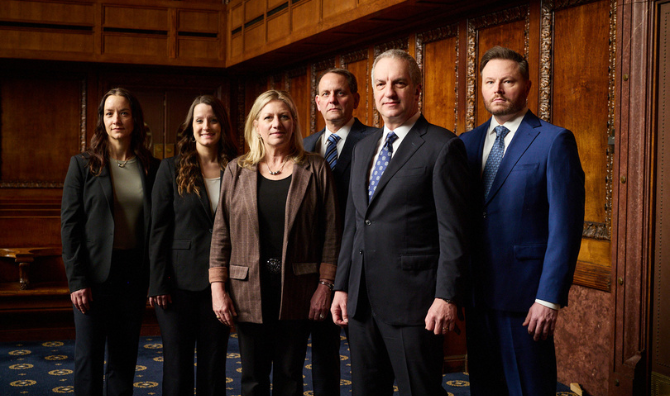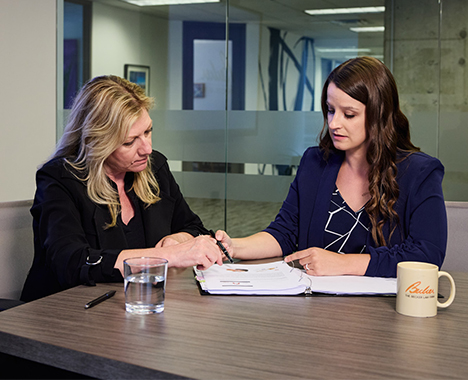As a firm that’s earned national recognition for record-setting results, and for our work in complex cases involving medical malpractice and birth injuries, The Becker Law Firm knows what profound suffering and consequences can result from the negligence of doctors, nurses, hospitals, and others who had obligations to provide adequate care to mothers and their babies.
With decades of legal experience, extensive resources, award-winning attorneys, and licensed medical professionals on staff, we have the tools to help families seek justice and compensation for serious birth injuries like cerebral palsy that could and should have been prevented.
If you suspect medical malpractice caused your child to be born with cerebral palsy, contact our firm for a free initial consultation: 216-621-3000.
Understanding Cerebral Palsy
Cerebral palsy is an incurable, non-progressive motor disorder which results from damage or abnormalities in areas of the brain that control movement and muscle coordination. Children born with this condition suffer physical impairment, usually profound and lifelong.
Though cerebral palsy is the most common motor disorder in children, research has shown it is often preventable. Typically, preventable cerebral palsy results from the mistakes of doctors and health care providers when treating pregnant mothers or facilitating labor and delivery.
For parents, the heartbreak and financial burden of caring for a child with cerebral palsy can be overwhelming. Most parents are concerned about what the future holds for their child and how they can afford to provide necessary support through childhood and into adulthood.
Is Cerebral Palsy a Birth Injury?
In about 70% of the children with cerebral palsy, the condition is congenital and present at birth, although it may not become evident until many months later. However, in about 20% of children with cerebral palsy, it is the result of an injury sustained during the birthing process.
The Becker Law Firm has a proven record of holding doctors and hospitals accountable when their negligence leads to birth injuries like cerebral palsy. With offices in Cleveland and Elyria, we handle cases across Ohio and are frequently called upon for co-counsel or advice from attorneys in other states.
Signs of Cerebral Palsy
Cerebral palsy is one of the many birth defects that are more easily treated the earlier it is detected. Both parents and doctors must be diligent in looking for the signs of CP in a newborn so treatment can begin as soon as possible. The signs may differ at various stages of life:
- 2-6 months: difficulty controlling head and/or stiff legs that cross or “scissor” when child is picked up;
- 6-10 months: continued difficulty controlling head movement, can reach with only one hand while fisting the other;
- 10-12 months: crawls by pushing off with one hand and leg while dragging the other side, cannot sit by themselves;
- 1-2 years: has not crawled, cannot stand without support;
- 2+ years: cannot walk, cannot push a wheeled toy.
Any abnormalities in your child’s movement or signs of delayed development in motor skills should be discussed with your doctor, as many other conditions can also cause these symptoms.
Common Causes of Cerebral Palsy
Although the most apparent symptoms of cerebral palsy are impaired movement and motor function, those impairments begin because of an injury to the brain. There are many different types of injuries that can cause cerebral palsy, including difficult labor that causes lack of oxygen to the brain, head trauma, meningitis, and infection.
Cerebral palsy in the unborn baby may develop during pregnancy or after birth but often results from (a) oxygen deprivation or (b) traumatic head injuries during labor and delivery. Cerebral palsy is commonly caused by misdiagnosis or negligence in prenatal care, improper birthing technique, or failure of medical staff to recognize fetal distress or newborn complications such as:
- Prolapsed umbilical cord
- Fetal distress resulting in delayed C-section
- Head trauma from forceps or vacuum extractor
- Newborn jaundice/kernicterus
- Premature birth
Fetal heart monitors and other vital sign monitoring should alert nurses to fetal distress and they should notify the doctor immediately. The OB/GYN or delivering caregiver must make the correct decision on continuing labor toward a vaginal delivery or surgical intervention.
Was My Child's Cerebral Palsy Preventable?
You’re not likely to get many answers from doctors. Even if a doctor admits that they made a mistake, it can be some time before your child is diagnosed with cerebral palsy. The doctors that make the diagnosis will not likely be willing to go back and see if it was something that happened at birth, much less to determine if it was preventable. To find out, you will likely need a lawyer.
Your lawyer will ask you questions, order the labor and delivery medical records, and order the baby’s medical records. After an initial review, those records may be sent to many experts for a formal opinion—obstetricians, neonatologists, and pediatric neurologists, to name a few.
Here are some questions which can help you determine if your child’s cerebral palsy may have been preventable:
- Did the baby’s heart rate have any problems during labor and delivery? Did you hear words like “late deceleration,” “distress,” or “non-reassuring?”
- How was the baby’s condition at birth? Did the baby require resuscitation, or was the baby crying and moving? Did the doctors tell you the baby’s Apgar score?
- Did the baby have an extended stay in the neonatal intensive care unit (NICU)?
- Did your child have seizures?
- Were any brain scans abnormal?
- During labor, did the doctors give the mother oxygen, turn her on her side, or give her intravenous fluids?
- Was the baby born by emergency C-section, or with the assistance of vacuum or forceps?
If you answered yes to any of these questions, it may be a good idea to investigate. Sometimes, babies develop cerebral palsy for unknown reasons, and sometimes no one is at fault. Either way, it’s better to know. When you contact The Becker Law Firm, we can help you get answers.
Cerebral Palsy Risk Factors and Statistics
Some babies have a higher risk of developing cerebral palsy. Babies who are born premature or with a low birth rate are more likely to have cerebral palsy. Studies also indicate that mothers over age 40 or under age 20 have a higher chance of delivering a baby who has cerebral palsy.
Children diagnosed with cerebral palsy after birth often have other medical conditions, including seizure disorders, developmental delays, and feeding problems.
Cerebral palsy statistics:
- One in every 278 children has some type of cerebral palsy
- 764,000 people in the United States have cerebral palsy
- 8,000 children are diagnosed with cerebral palsy every year in the United States
- 30% of children with cerebral palsy have a seizure disorder
- Proper care of a child with cerebral palsy may require $1 million or more
If your baby was diagnosed with cerebral palsy, and you think medical negligence is to blame, call 216-621-3000 to speak with our cerebral palsy attorneys in Cleveland. The Becker Law Firm provides free consultations.
Different Types of Cerebral Palsy
There are different types of CP, manifesting in a range of motor and sensory impairments. Those afflicted may have problems with coordination and balance, uncontrollable tremors, weak muscle tone, or no muscle control at all. They may have loss of speech, hearing impairment, and vision conditions. Spasms and muscular atrophy often develop into permanent deformities.
Cerebral palsy can be categorized using a variety of diagnostic and organizational systems which focus on the condition’s key characteristics, such as its severity, impact on muscle tone and limbs, and extent of impairment. Generally, however, it is classified as one of three main types.
Spastic Cerebral Palsy
As the most common form of the condition, spastic cerebral palsy is characterized by muscular spasms and hypertonia, meaning severe tension in the muscles caused by too much muscle tone. Children with this type of CP often experience involuntary contractions and spasms, as well as pain and stress affecting the muscles. It may also coincide with scoliosis, hip dislocation, joint deformities, and other additional conditions or side effects. Experts note the hypertonia which occurs with spastic cerebral palsy is caused by brain damage, and specifically lesions in the central nervous system’s UMNs (upper motor neurons), which control voluntary movement.
Dyskinetic / Athetoid Cerebral Palsy
Athetoid / dyskinetic cerebral palsy accounts for as much as 20% of all cerebral palsy cases, and is characterized by a combination of hypertonia (too much muscle tone and stiffness), hypotonia (too little muscle tone and contraction impairment), and involuntary spasms. It typically results from brain damage in the basal ganglia, which helps control and regulate voluntary movement, and is commonly caused by hypoxic-ischemic encephalopathy or kernicterus.
Children with this type of cerebral palsy, which is further classified into dystonia, athetoid, and chorea subgroups, may have involuntary contractions and abnormal posture, involuntary slow or writhing movements, or involuntary jerking spasms. This may manifest in difficulties with a child’s ability to walk, hold objects, perform fine motor functions, swallow or talk, and sit upright.
Ataxic Cerebral Palsy
The least common form of cerebral palsy, ataxic CP results from damage to the cerebellum, the part of the brain which regulates and coordinates muscle activity. Children with ataxic cerebral palsy typically display problems with controlled movements and with the execution of fine motor functions. This includes problems with balance or coordination for larger movements like walking, as well as difficulties with precise actions such as writing. Hypotonia, or a lack of muscle tone which impedes the muscle’s ability to contract, is a common characteristic of ataxic cerebral palsy in young children, as are visual problems and difficulties with speech.
Most children with cerebral palsy have no cognitive deficits, yet they are trapped in a body that won’t cooperate. Parents suffer too, from the grief, exhaustion of round-the-clock care, and financial pressures. Care for a child with cerebral palsy can easily exceed millions of dollars over a lifetime. However, with the help of a Cleveland cerebral palsy lawyer from The Becker Law Firm, you and your family can seek the compensation necessary to give your child a full life.
Treatment for Cerebral Palsy
Children with cerebral palsy can be loving, intelligent and successful. Some forms of cerebral palsy are mild, while others are more severe. However, every child should be allowed to reach his or her full potential.
Access to innovative medical technologies and specialists can allow them to reach that potential, including:
- Orthopedists
- Psychologists
- Physical therapists
- Occupational therapists
- Speech-language pathologists
- Pediatric neurologists
- Social workers
A child’s quality of life can improve with therapy, mobility aids, and even assistive communication devices. Surgery can sometimes help to loosen up the limbs and prevent worsening contractures. Repeated physical therapy can help children to train their bodies to perform ordinary tasks that are made difficult by their condition.
Contact Us Today for a Free Case Review
Since being founded in 1980, The Becker Law Firm has been committed to fighting for individuals and families following preventable tragedies, injuries, and illnesses caused by negligence.
If your child was born with cerebral palsy you believe was caused by medical negligence, our firm is available to review your situation, discuss whether you may have a potential claim, and explain what we can do to protect your rights as we seek justice and financial compensation.
In every case, our Cleveland cerebral palsy attorneys work with medical experts who create a comprehensive Life Care Plan detailing the medicine, surgeries, therapies, and adaptive equipment that your child will need now and into the future as a result of their injury.
Contact The Becker Law Firm online or by phone at 216-621-3000 to schedule your free initial consultation. We help families throughout Ohio.



